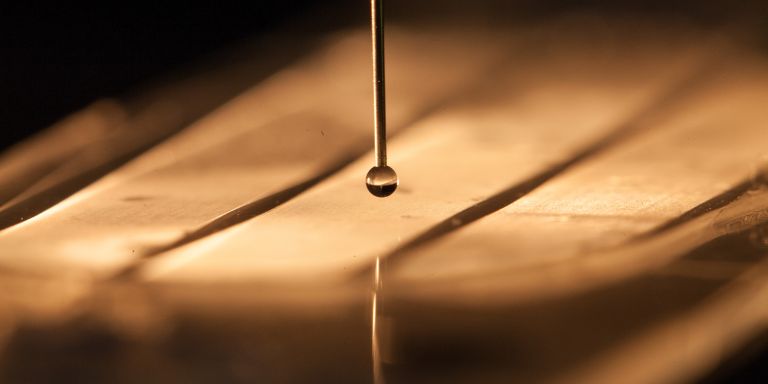
Shervin Bagheri
Professor of Fluid Mechanics
Wallenberg Academy Fellow 2016
Institution:
KTH Royal Institute of Technology
Research field:
Optimization of poroelastic surfaces


Wallenberg Academy Fellow 2016
Institution:
KTH Royal Institute of Technology
Research field:
Optimization of poroelastic surfaces
As soon as we move through air, for example, drag is created. Bagheri explains:
“It’s thought that more than ten percent of the world’s energy consumption goes on surmounting this kind of resistance. We want to tailor-make surfaces to reduce drag,” he says, pulling some Savoy cabbage out of his backpack.
He places a water droplet on a cabbage leaf, and tilts it slightly. The droplet keeps its spherical shape and rolls quickly off the leaf. Just as he does when teaching his fluid mechanics students at KTH Royal Institute of Technology, Bagheri points out that, on close inspection, the surface of the cabbage leaf is not particularly smooth.
“We can see millimeter-sized dimples on the leaf. Under a microscope we can see even smaller structures. On the surface of these tiny depressions there are elastic nanohairs. Dimples and nanohairs combine to produce surface characteristics of great interest.”
Savoy cabbage, like shark skin, and bat and butterfly wings, is a good example of a type of low-friction surface that no-one has managed to reproduce artificially. Bagheri wants to try. He is developing advanced computer models to create bio-inspired surfaces that allow fluids such as air and water to pass over them with less resistance.
Bagheri was born in Iran, and was nine years old when his family moved to Sweden. He grew up in Lund, and soon became interested in the sciences, thanks in large part to a biology teacher who made a great impression on him. After graduating in physics engineering at Uppsala University, he was at a crossroads: to become a researcher or work in industry.
“For me it’s important to make a difference. I pondered long and hard over how I could do so. Finally, I ended up at KTH, where I received a PhD in Fluid mechanics.”
Bagheri was working as a postdoc in Italy when he came across biomimetics, the field in which technological developments are inspired by natural phenomena. He and his colleagues at Genoa University made a fascinating discovery.
“Imagine a strand of hair attached to the back of a body, like a ball with a tiny tail. It is then exposed to a flow of water, for example. When we did this, we found that the hair dramatically changed the behavior of the flow around the body – there was less resistance. We could also create a lift force or a lateral force.”
On his return to KTH he wanted to continue on the same track.
“The surfaces of biological organisms have much more complex structures than the hairs we have studied. Surfaces are often porous and elastic. I want to find out what happens when liquids and gases flow over a poroelastic surface of this kind.”
Bagheri stresses that the question of how porous, slippery and elastic surfaces and a flowing fluid interact is scientifically interesting. But this knowledge may also play a major role in the development of new energy-efficient technologies.
“I wish that the type of flows that the material will be exposed to, such as turbulence for materials used for automobiles or turbine blades, would be taken in account already at the design stage.”
Bagheri is concentrating on modeling and calculating flows with the help of computer simulations. This is a field where great strides have been made, he says, but it’s a little more difficult when it comes to large surfaces:
“That’s true – because it’s a multiscale problem. Properties at the lowest size level in the structure impact the flow – vortices can occur at the surface, for example. The biggest challenge we face is to model properties from the nanoscale through the microscale, and on to a scale we can see with the naked eye.”
The models use data produced by biologists. The aim is to find the parameters that result in the most functional materials.
“We have managed to develop a really accurate model of a porous and elastic surface, and the interface between the surface and a flowing fluid. It’s taken us a few years, and has been essential to our further progress. It feels great, so now we’re itching to take the next step.”
“It’s a wonderful position to be in. The grant means I can freely conduct independent basic research over the long term. I can build up my own research team, put the pieces of the jigsaw together and spread the risks between different projects.”
Fairly simple experiments to test the hypotheses are carried out in the fluid mechanics laboratory. Tests are performed on hairy surfaces that other researchers at KTH have helped to produce using UV lithography.
“Some surfaces may be chemically treated. We place a droplet of water on the surface and see the shape it assumes and how it spreads. We are also studying how the structures interact with the fluid.”
The project has received a five-year grant from the Knut and Alice Wallenberg Foundation. Bagheri doesn’t want to do research driven purely by curiosity.
“That kind of research is needed too. But it would irresponsible of me as a researcher in engineering science if I didn’t try to help meet our climate and environmental objectives. One way I can make a difference is to use fluid mechanics to develop new technology that makes transport and industrial processes more energy-efficient,” he explains.
Text Susanne Rosén
Translation Maxwell Arding
Photo Magnus Bergström